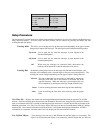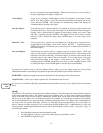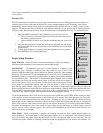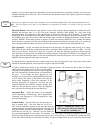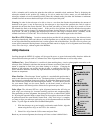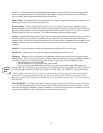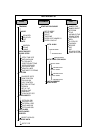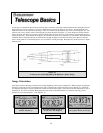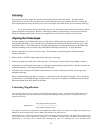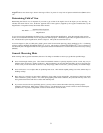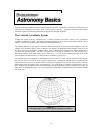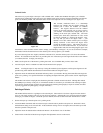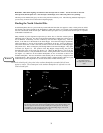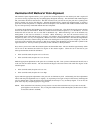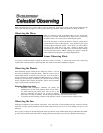30
F
F
o
o
c
c
u
u
s
s
i
i
n
n
g
g
To focus your telescope, simply turn the focus knob located directly below the focuser. Turning the knob
clockwise allows you to focus on an object that is farther than the one you are currently observing. Turning the
knob counterclockwise from you allows you to focus on an object closer than the one you are currently observing.
• If you wear corrective lenses (specifically glasses), you may want to remove them when observing with an
eyepiece attached to the telescope. However, when using a camera you should always wear corrective lenses to
ensure the sharpest possible focus. If you have astigmatism, corrective lenses must be worn at all times.
A
A
l
l
i
i
g
g
n
n
i
i
n
n
g
g
t
t
h
h
e
e
F
F
i
i
n
n
d
d
e
e
r
r
s
s
c
c
o
o
p
p
e
e
Accurate alignment of the finder makes it easy to find objects with the telescope, especially celestial objects. To
make aligning the finder as easy as possible, this procedure should be done in the daytime when it is easy to find
and identify objects. The finderscope has a spring-loaded adjustment screw that puts pressure on the finderscope
while the remaining screws are used to adjust the finder horizontally and vertically. To align the finder:
1 Choose a target that is in excess of one mile away. This eliminates any possible parallax effect between the
telescope and finder.
2 Release the R.A. and DEC clamps and point the telescope at your target.
3 Center your target in the main optics of the telescope. You may have to move the telescope slightly to center it.
4 Adjust the screw on the finder bracket that is on the right (when looking through the finder) until the cross hairs are
centered horizontally on the target seen through the telescope.
5 Adjust the screw on the top of the finder bracket until the cross hairs are centered vertically on the target seen
through the telescope.
Image orientation through the finder is inverted (i.e., upside down and backwards left-to-right). This is normal for
any finder that is used straight-through. Because of this, it may take a few minutes to familiarize yourself with the
directional change each screw makes on the finder.
Calculating Magnification
You can change the power of your telescope just by changing the eyepiece (ocular). To determine the magnification of your
telescope, simply divide the focal length of the telescope by the focal length of the eyepiece used. In equation format, the
formula looks like this:
Focal Length of Telescope
(mm)
Magnification =
⎯⎯⎯⎯⎯⎯⎯⎯⎯⎯⎯⎯⎯⎯
Focal Length of Eyepiece
(mm)
For example, to determine the magnification of the 80ED with a 20mm eyepiece, divide the focal length of the spotting scope
(600mm) by the focal length of the eyepiece (20mm). 600 divided by 20 yields 30 power.
Although the power is variable, each instrument has a limit to the highest useful magnification. The general rule is that 60 power
can be used for every inch of aperture. For example, in a 3.2” diameter telescope, such as the 80ED, the maximum useful
magnification is 192 power. This is derived from multiplying 60 times 3.2”. Although this is the maximum useful



